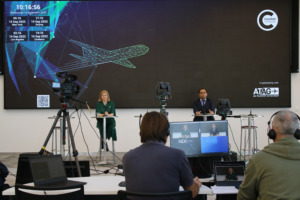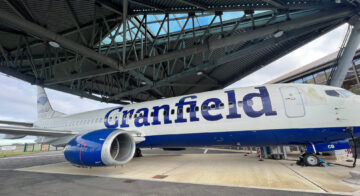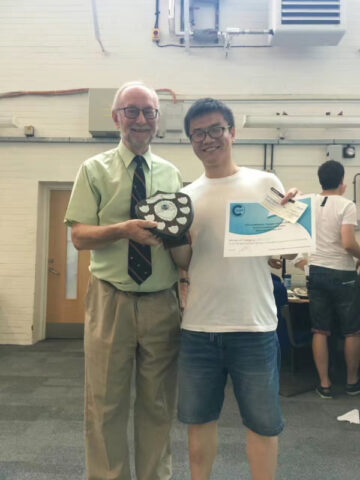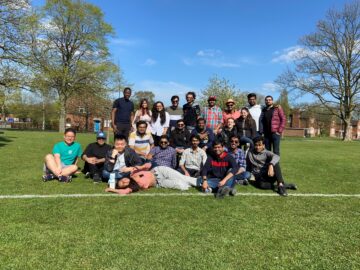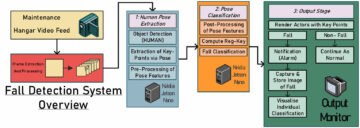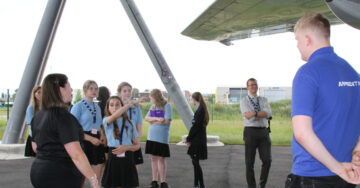Cranfield University has offered me countless opportunities in the short time I have been here, and I am committed to making the most of them.
As an expert in drones and uncrewed aircraft systems, I make it a habit to engage with student UAS activities wherever I go. Cranfield University has provided me with the perfect platform to do just that! With the support of my MSc in Autonomous Vehicle Dynamics and Control, which sits within the Centre for Autonomous and Cyber-Physical Systems, I have achieved more than I ever anticipated.
The course adopts a holistic approach to learning, providing a comprehensive understanding of autonomous systems, including their physical dynamics, controls theory, artificial intelligence, guidance, navigation, and more. This emphasis on cutting-edge research is what drew me to the course as well as the state-of-the-art facilities, such as the Indoor Flying Arena, have further amplified my research work.
.fusion-gallery-1 .fusion-gallery-image {border:0px solid #e2e2e2;}
Before delving into extracurricular activities, as part of my Group Design Project (GDP) group I undertook a challenging task: building an autonomous swarm of drones for surveillance. Sponsored by Leonardo, this project required us to construct an indoor GPS-denied swarm of drones capable of navigating with a motion capture system to detect and track unknown ground vehicles within an area. Despite the numerous hurdles we faced, including long hours of dedication from mid-January until March, we successfully delivered on Leonardo’s specifications. You can see the demonstration video of our GDP project here.
What you witness in the demonstration is two drones in a centralised swarm conducting an area search in an indoor environment to locate ground vehicles. Upon detecting a ground vehicle, the intelligent swarm pauses to track it before continuing the search. This capability is crucial for surveillance scenarios and demonstrates the potential for more advanced swarming technologies, as desired by Leonardo. Moreover, the swarm is designed to support the loss of a team member, ensuring the overall system’s continuity, even in the event of an agent malfunction or loss.
.fusion-gallery-2 .fusion-gallery-image {border:0px solid #e2e2e2;}
Simultaneously with my GDP, I was involved in another exciting initiative with CranSEDS: the Solar UAV Prototype. CranSEDS is a student society with Cranfield University, which also forms part of the branch of the UKSEDS (UK Students for the Exploration and Development of Space). The group is comprised of students who are passionate about space, technology and engineering from across the university.
Sponsored by GDST London and Airbus, this project tasked CranSEDS with developing a proof-of-concept for area survey and mapping over the Arctic to locate polar icebergs. As one of the project managers, I oversaw the design, development, and management of the team. The CranSEDS Solar UAV team successfully designed, built, and test flew the aircraft from scratch. With the maiden flight just completed, we are now gearing up to install solar cells on the UAV for its next flight, scheduled for the second week of June. Follow the CranSEDS Solar UAV LinkedIn.
.fusion-gallery-3 .fusion-gallery-image {border:0px solid #e2e2e2;}
(UIAS) Society at Cranfield University. The society focuses on student development in uncrewed systems and oversees all student-led UAS activities. This year, we have been conducting demonstrations for autonomous systems to external visitors and participating in the IMechE UAS Challenge 2024. Our team is building a 2+2 tilt rotor VTOL quad-plane capable of carrying 2kg of payload for the challenge. With the support of the Cranfield UAS Operations Team and the Centre of Autonomous and Cyber Physical Systems, we aim to test fly the aircraft by the end of May 2024.
.fusion-gallery-4 .fusion-gallery-image {border:0px solid #e2e2e2;}
There is much more happening at Cranfield, and being at the forefront of all UAS activities provides me with a spotlight I relish. Balancing the demanding academic workload of the MSc program with such enriching extracurricular experiences sets me apart. Moreover, projects that translate theoretical knowledge into tangible solutions have a far greater impact. Cranfield University has offered me countless opportunities in the short time I have been here, and I am committed to making the most of them.
- SEO Powered Content & PR Distribution. Get Amplified Today.
- PlatoData.Network Vertical Generative Ai. Empower Yourself. Access Here.
- PlatoAiStream. Web3 Intelligence. Knowledge Amplified. Access Here.
- PlatoESG. Carbon, CleanTech, Energy, Environment, Solar, Waste Management. Access Here.
- PlatoHealth. Biotech and Clinical Trials Intelligence. Access Here.
- Source: https://blogs.cranfield.ac.uk/aerospace/advancing-uncrewed-aerial-systems-my-journey-at-cranfield-university/
- :has
- :is
- $UP
- 2016
- 2024
- 37
- 4
- 48
- 5
- 6
- a
- About
- AC
- academic
- achieved
- across
- activities
- advanced
- advancing
- Agent
- aim
- Airbus
- aircraft
- All
- also
- am
- Amplified
- an
- and
- Another
- apart
- approach
- arctic
- ARE
- AREA
- Arena
- artificial
- artificial intelligence
- AS
- At
- author
- auto
- autonomous
- autonomous systems
- autonomous vehicle
- balancing
- been
- before
- being
- blogs
- Branch
- Building
- built
- by
- CAN
- capability
- capable
- capture
- carrying
- Cells
- centralised
- centre
- challenge
- challenging
- classic
- CO
- committed
- Completed
- comprehensive
- Comprised
- conducting
- construct
- continuing
- continuity
- controls
- countless
- crucial
- cutting-edge
- cyber
- dedication
- delivered
- delving
- demanding
- demonstrates
- demonstration
- Design
- designed
- desired
- Despite
- detect
- detecting
- developing
- Development
- diagram
- do
- Drones
- dynamics
- emphasis
- end
- engage
- Engineering
- enriching
- ensuring
- Environment
- Even
- Event
- exciting
- Experiences
- expert
- exploration
- external
- faced
- facilities
- far
- flight
- flying
- focuses
- For
- forefront
- forms
- from
- further
- GDP
- gearing
- Go
- greater
- Ground
- Group
- guidance
- habit
- Happening
- Have
- here
- holistic
- HOURS
- hover
- HTTPS
- Hurdles
- i
- Impact
- in
- Including
- Indoor
- Initiative
- install
- Intelligence
- Intelligent
- into
- involved
- IT
- ITS
- journey
- jpg
- june
- just
- knowledge
- learning
- London
- Long
- loss
- make
- Making
- management
- Managers
- mapping
- March
- May 2024
- May..
- me
- member
- more
- Moreover
- most
- motion
- Motion capture
- msc
- much
- my
- navigating
- Navigation
- next
- None
- now
- numerous
- of
- offered
- on
- ONE
- Operations
- opportunities
- or
- our
- over
- overall
- part
- participating
- passionate
- perfect
- physical
- platform
- plato
- Plato Data Intelligence
- PlatoData
- polar
- potential
- Program
- project
- projects
- prototype
- provided
- provides
- providing
- required
- research
- review
- Reviews
- scenarios
- scheduled
- scratch
- Search
- Second
- see
- Sets
- Short
- sits
- Society
- solar
- Solar cells
- solid
- Solutions
- Space
- specifications
- Sponsored
- Spotlight
- state-of-the-art
- Student
- Students
- Successfully
- such
- support
- surveillance
- Survey
- Swarm
- system
- Systems
- tangible
- Task
- tasked
- team
- Technologies
- Technology
- test
- than
- that
- The
- their
- Them
- theoretical
- theory
- this
- this year
- time
- to
- track
- translate
- two
- UAV
- Uk
- understanding
- undertook
- university
- unknown
- until
- upon
- us
- vehicle
- Vehicles
- Video
- visitors
- was
- we
- week
- WELL
- What
- wherever
- which
- WHO
- with
- within
- witness
- Work
- XML
- year
- you
- zephyrnet






